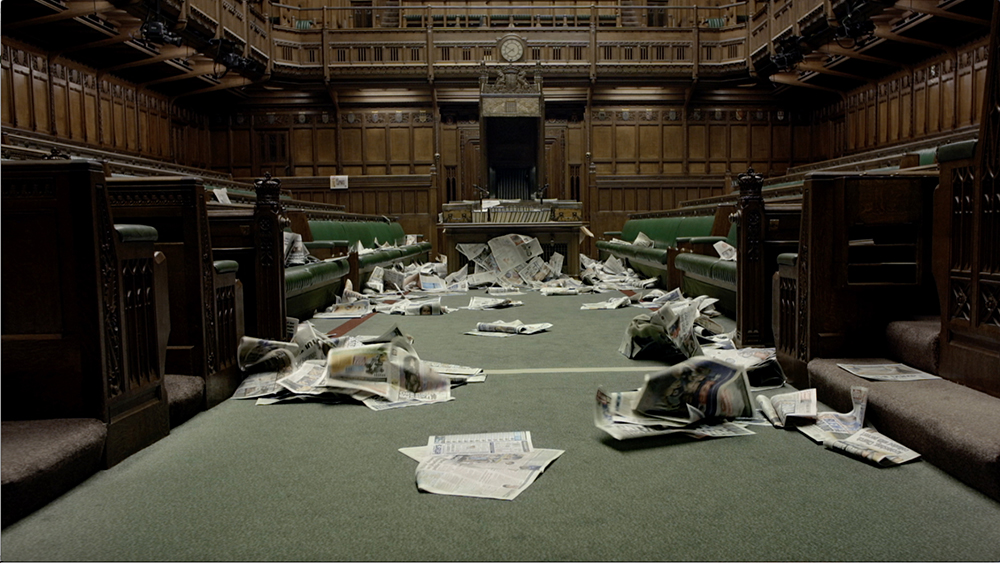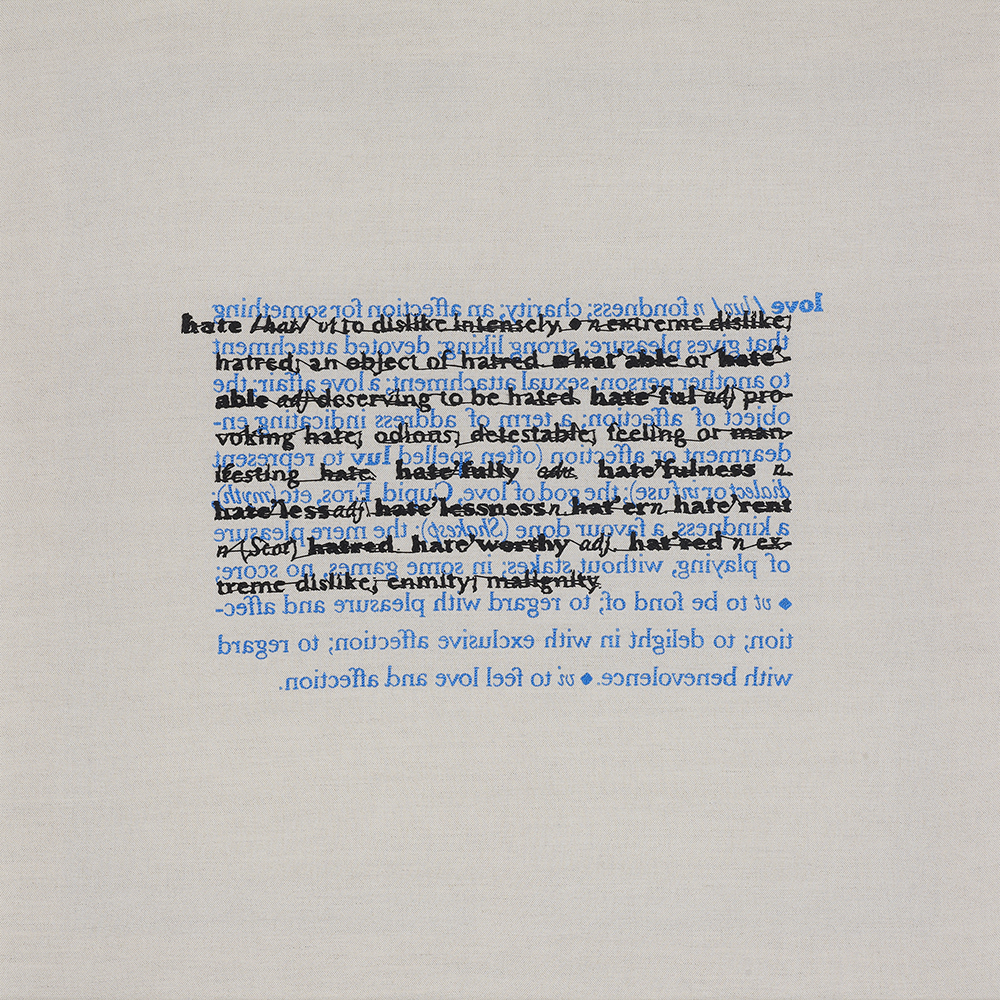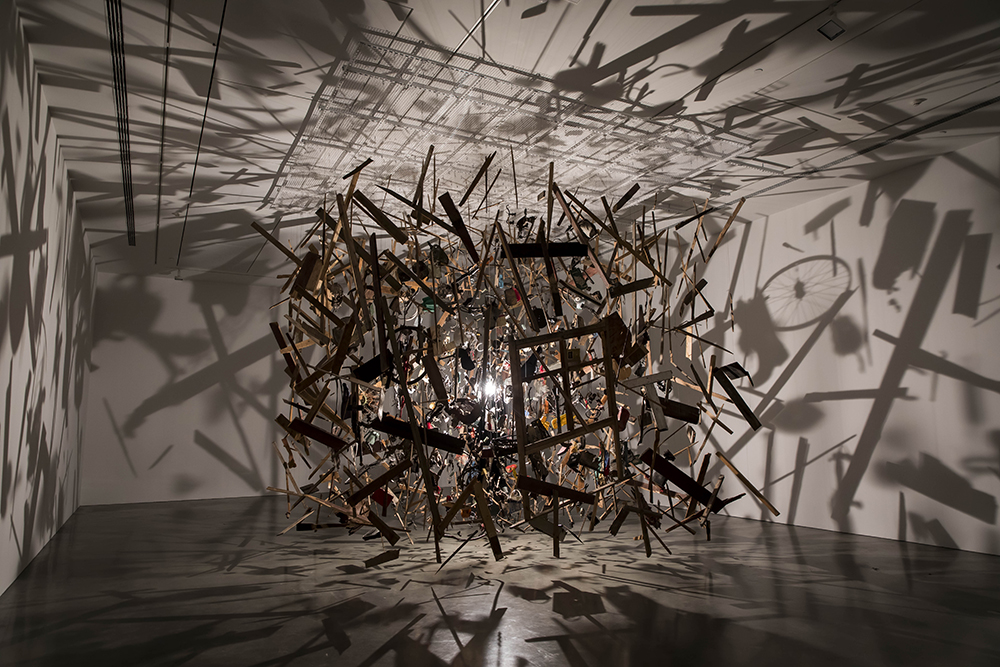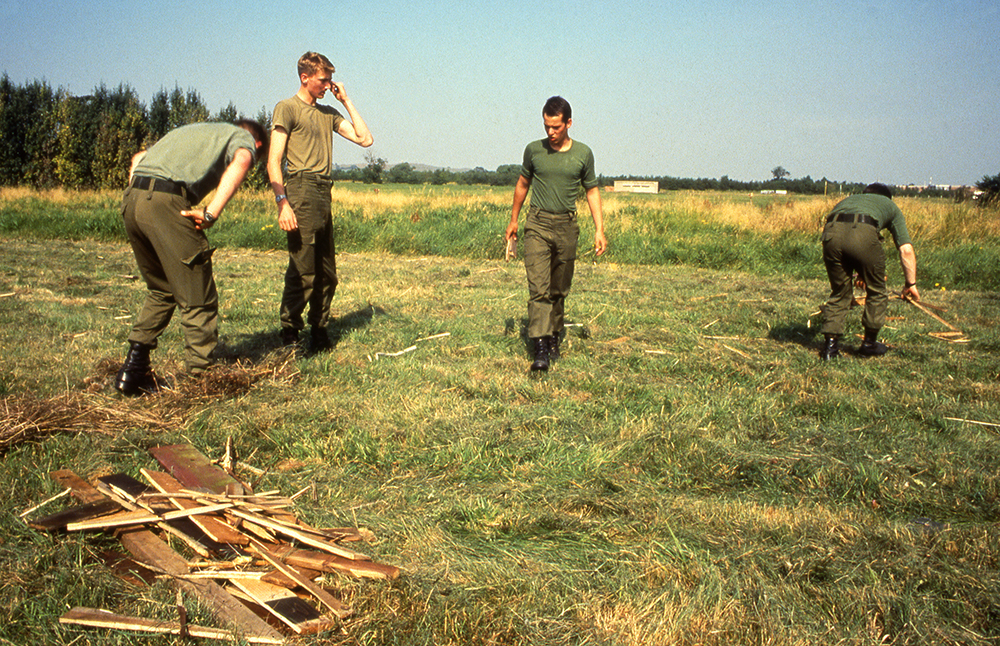Cornelia Parker:

By Naomi Riddle
21 February, 2020
The Museum of Contemporary Art’s summer exhibition, Cornelia Parker, is a retrospective of the celebrated British artist’s work. Parker is the tenth artist to feature in the Sydney International Art Series—an initiative undertaken in partnership with the NSW Government to bring internationally recognised artists to Australian audiences.
Parker is best known for her large-scale installations, such as ‘War Room’ (2015), a tented monument constructed out of discarded red strips from the Poppy Factory in England, or ‘Transitional Object (PsychoBarn)’ (2016), a 30-foot double facade inspired by Edward Hopper and Alfred Hitchcock, perched on the rooftop of the New York Metropolitan Museum of Art.
Yet the strongest works in this exhibition are the smallest. There is an assured simplicity to ‘Inhaled Cliffs’ (1996), a collection of neatly stacked sheets that have been starched with chalk from the White Cliffs of Dover, and ‘Embryo Firearms’ (1995), two flattened and toy-like Colt 45 guns in the earliest stage of production. For ‘The Negative of Words (ii)’ (1996), Parker has accumulated the shavings left behind from metallic engravings and formed them into a small pile.
In these quieter moments—ones that seem less about political statements and more about what we recognise and classify objects to be—Parker displays her decades-long fascination with materials: how morphing or reconfiguring objects can alter their meaning entirely. Taken together, these early works reiterate that Parker is first and foremost concerned with aesthetics—with how to make materials move, shift, expose, or hide themselves.
However, Cornelia Parker suggests that it is the political that is central to her practice. Rachel Kent, the exhibition’s curator, describes her work as being about ‘opposing states’: ‘order and chaos, peace and violence, law and lawlessness…Set against the backdrop of Brexit, global migration and the threat of terror.’ Indeed, much of Parker’s work deals in juxtaposition—placing opposites or binaries next to (or on top of) one another in order to expose how they are dependent or interrelated. No more is this evident than in Parker’s text works, where dictionary definitions of two opposing words—Right/Wrong, Love/Hate—are stitched in reverse and overlaid over one another, the threads of their differing meanings touching and overlapping.

Cornelia Parker, Love, Hate (2015), hand embroidered by prisoners in HM Prisons, The Whitworth, The University of Manchester, image courtesy the artist, The Whitworth, The University of Manchester and Frith Street Gallery © the artist,
Image credit: Michael Pollard
But juxtaposition is a fickle beast. ‘I like putting together definitions that are oppositional,’ states Parker, but she doesn’t allude to the reasons why. I want to ask Parker: ‘to what end?’ Putting opposites together has the ability to wound just as much as it has the ability to connect (our Facebook or Twitter feeds provide enough evidence of this alone). Juxtaposition can make things equivalent rather than different or shocking. And the act of placing things side-by-side can flatten all manner of complexity.
Parker is deploying the technique of ‘antithesis’, where two opposing ideas are put together in order to achieve contrasting effect. But antithesis is a rhetorical figure, not an endpoint. To use it alone is to evacuate rhetoric of its purpose: to persuade us into some form of action or response.
These concerns are most evident in Parker’s stitched cloth—‘Magna Carta (An Embroidery)’ (2015). Billed as one of the key works of the exhibition, and hand stitched by two-hundred people, ‘Magna Carta’ depicts the Wikipedia entry that details the meaning, history and legacy of the famous treatise. Instated by King John of England in 1215, during a time of political crisis, the Magna Carta established the fundamental principle that everyone is subject to the law. Of the sixty-three clauses contained within it, only three are still part of British law. Nonetheless, the document remains (to Britain) a potent treatise symbolising the importance of the law, equal rights for all, and guarding against tyrannical rule.
But what is of most significance here is who is doing the stitching. Parker details, at length, in both the work’s description, and the video alongside it, that the piece has been made by British prisoners via the charity Fine Cell Work, with other notable contributions by barristers, experienced embroiderers, Julian Assange, Edward Snowden, and a hodgepodge of major and minor celebrities, baronesses, and lords. It is important to note that the labour of prisoners features largely across Parker’s retrospective as a whole, with many of the text works involving participants from Fine Cell Work.
‘I want [‘Magna Carta’] to embrace every corner of the system,’ Parker says in the video. ‘The law should be about making sure that everybody is treated fairly, and I feel like we’ve lost that [my emphasis].’ In her curator’s introduction to the retrospective, Kent writes that the stitching has been conducted by those ‘on both sides of the law [my emphasis].’ ‘Magna Carta’, therefore, is asking us to consider another cascade of oppositions: offender/defender, criminal/lawyer, expert/amateur, layperson/peer, freedom/incarceration, subject/object, judge/jury, individual/other, and the ‘right’ side of the law/the ‘wrong’ side of the law.
But what is the effect of placing the stitches of all of these people (and the symbolic value of these people) alongside one another? Edward Snowden’s experience of statelessness in Russia is not equatable to that of the unnamed prisoner who, Parker tells us, has since reoffended. The daily life of the aristocrat, or the embroiderer, is not equatable to that of the human rights lawyer or the wrongly accused. On the wall text beside the work, it appears likely that the contributors listed only by their first name are those that remain incarcerated in British prisons.
The prisoners’ agency is reduced, their participation and consent opaque, and the shininess of their plight dimmed when compared to the buzz-names of Snowden or Mariella Frostrup. Another way of putting it: the incarcerated are objectified, while TV presenters, politicians and judges are individualised.
‘Magna Carta’ is beautiful, and there is no denying the painstaking labour evident in the embroidery. The detail contained within each small Wikipedia ‘image’ is a testament to the skill of the makers. But I cannot look at the work and ignore how the history of Britain (this ‘time before’ that Parker likes to speak of) is the history of a country using the law as a means with which to subjugate, oppress, and steal. Nor can I not see the relationship between prisoner, needlework, cotton and thread, and not think about the ‘new Jim-Crow’, indentured slavery, criminal justice reform, and calls for prison abolition. Then there is the other contemporary context: the newly elected Tory government with its promises to fund 10,000 more prison places, to increase the number of stop-and-searches, extend sentences for serious offenders, and hire 20,000 extra police officers by 2022. In the face of this, the Magna Carta, and its symbolic potential, is diminished.
Perhaps I am demanding too much of Parker’s work. Or perhaps I am placing my own context—my politics, or ways of making meaning—on top of a work that is more about Wikipedia, embroidery, and communal labour, than anything else. But I am led to these thoughts because of the way Parker’s work is presented. It is a retrospective curated in such a way that Parker’s discussion of her work is the primary access point. Nearly all the wall labels quote Parker in some way, expanding on her reasons for making a particular work. An entire gallery space is dedicated to a documentary that takes us through the history of Parker’s practice. There are videos that include artist interviews and behind-the-scenes footage. Far from opening up meaning, this somewhat didactic mode of curation forecloses it—the affect, value, message, and significance of a work is placed squarely in the hands of the artist.

Cornelia Parker, Cold Dark Matter: An Exploded View (1991), installation view
Image courtesy the artist, Museum of Contemporary Art Australia and Frith Street Gallery, London
Image Credit: Anna Kučera
‘Cold Dark Matter: An Exploded View’ (1991) consists of the remains of a garden shed and the objects housed within it. These objects were either found, or donated by Parker’s friends, and include a tricycle, rubber boots, a can of paint, dolls and a tennis racket. With the assistance of the British Army (who Parker thanks in the wall text), a nondescript garden shed was filled with these collected objects and then detonated. The shed and its contents are then presented in the gallery, in a literal ‘exploded view’ suspended from the ceiling. Each object—such as a window frame or a piece of wood—appears to be caught in the midst of the explosion: the tricycle’s legs are contorted from the heat, while a side of the paint can bulges outwards. All of these objects are archetypally British (a white middle-class Britishness), and Parker describes the work as a way of ‘trying to make sense of things that are unpalatable, like watching explosions on the daily news.’
Somewhat akin to the end scene of Antonioni’s Zabriskie Point (1970)—an eight minute extravaganza of household items exploding in slow motion to the music of Pink Floyd—‘Cold Dark Matter’ is about viewing the effect of detonation from a safe distance. It is also Parker’s most celebrated, most well-known, and most photographed work. But, just as Parker references the media’s involvement in broadcasting images of obliteration, I am suspicious that what we are looking at is a spectacle on top of a spectacle—one whose image is equally shareable and reproducible.
At best, ‘Cold Dark Matter’ is a naïve work whose meaning is radically altered in a post-9/11, post-‘Axis of Evil’ world. At worst, it is unintentionally cruel. This cruelty seems all the more pronounced because the installation is positioned between the video works ‘Made in Bethlehem’ (2012) and ‘Chomsky Abstract’ (2007)—edited footage of Noam Chomsky discussing American militarism and fanaticism. In enlisting and thanking the British Army for their assistance with ‘Cold Dark Matter’, Parker aligns herself with the army of a nation responsible for terminating its mandate with Palestine in 1947. It is also an army that participated, at the direction of Tony Blair, in bombing and invading Iraq under false pretenses. (Significantly, Chomsky details this campaign of violence, although from an American perspective, next door. And although it’s a riveting interview, its primary purpose appears to be to lend a kind of ‘rigour by association’ to ‘Cold Dark Matter’, which feels somewhat disingenuous.)
For me, ultimately what the installation seems to be suffering from is the colonial fantasy that it is the empirical centre that is most at threat from explosive violence. In reality, these explosions are happening elsewhere (Syria, Iraq, Afghanistan, Palestine), and often as a result of British foreign policy. Far from exploring or navigating this fraught connection, or to use Parker’s words, that which is ‘unpalatable’, ‘Cold Dark Matter’ distances itself from this discussion. In asking for the army’s help to undertake a ‘safe’ explosion, Parker is treating the force behind the explosion as benign.

Cornelia Parker, Cold Dark Matter: An Exploded View (work in progress), (1991), image courtesy the artist and Frith Street Gallery, London © Hugo Glendinning, all Rights Reserved, DACS/ Artimage (2019)
Image Credit: Hugo Glendinning
I’ve visited Cornelia Parker multiple times. And what becomes more notable with each visit is the way she draws on, and, in some cases, relies on, the mechanisms of the state. To Parker, the government, the House of Commons, the parliament, the election cycle, the justice system, are British institutions. And if there is any critique of these institutions to be found in the exhibition, it is of the lightest possible touch. Again, the reason why I feel compelled to focus on this is that Parker seems insistent on referring to the political when describing her work, even when it appears that what she is most interested in is materiality (whether that be needle and thread, mass-produced steel, or collected social media footage).
Two of the most recent works in the exhibition are the videos ‘Left Right & Centre’ (2017) and ‘Election Abstract’ (2018), both made during Parker’s tenure as the 2017 Election Artist for the UK general election. The Speaker’s Advisory Committee on Works of Art awards this position every election, and a key demand is that the artist remain politically neutral. Incidentally, the Speaker during Parker’s posting was John Bercow—a former conservative minister who is best known for using an archaic law to stymie a key Brexit vote, and for being accused of supporting the Remainers. ‘I was told that I couldn’t be biased in any way,’ writes Parker. ‘I thought: how am I going to do that? In the end, I found I enjoyed the limitations and they were an aid to greater creativity.’
‘Left Right & Centre’ features the familiar green couches and wood panelling of the House of Commons. A collection of newspapers printed during the election occupy the centre table. Highlighting the right/left divide of the press, the camera pans slowly across the front pages of the Financial Times, The Daily Telegraph, The Daily Mirror and The Sun. The video ends with an ominous gust of wind, causing the partisan headlines to be tossed into a florid mess. In comparison, ‘Election Abstract’ is an ad-hoc montage, comprised of footage Parker collected during the 2017 campaign: we see local organisers, Grenfell protestors, right-wingers attacking BBC reporters, British flags, climate activists, the Green party, train carriages and town hall meetings.

Cornelia Parker, Left Right & Centre (still), (2017)
video, colour, sound, image courtesy the artist and Frith Street Gallery, London © the artist
While both of these works demonstrate May’s dismal election result and an ascendant Jeremy Corbyn, they are now overshadowed by the 2019 general election. May is out, Boris is victorious, Corbyn lost the ‘red wall’ to the north, and the left has been thoroughly trounced.
The figure of Boris Johnson (and his successes) looms large over Parker’s work because he embodies a parody of the type of Britishness that Parker—albeit inadvertently—can almost be seen to be an advocate for. And herein lies the problem.
Although most of the work on display in Cornelia Parker was made before the 2016 referendum, nearly all of Parker’s references (the Magna Carta, the red poppy, the garden shed, the gumboots) have now been co-opted by jingoistic Brexiteers. The post-Brexit country that Boris Johnson promises is an autonomous Britain not governed by Europe, where British Law is once again reinstated in the hands of the nation. Boris speaks to the (white) Britain of Churchill; the Britain that survived two world wars.
That a kind of unintended nationalism now permeates Parker’s work is, paradoxically, what makes this retrospective worthwhile. It suggests, whether inadvertently or not, the ways in which meaning, and potency, can shape-shift through and around an artist’s work. It confirms that there are unforeseen places to which meaning will inevitably move. A retrospective can become filled with fault lines and cracks—gaps that have unintended reverberations, which then create their own ricochet effects. What David Cameron, Theresa May, Jeremy Corbyn, the parliament, the crown, and the entire British electorate have learnt is that Brexit can tread on everything. Time, as is its wont, will do the same.